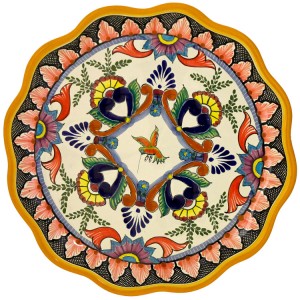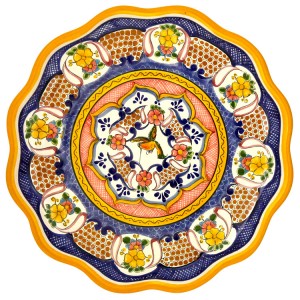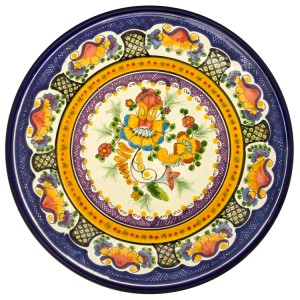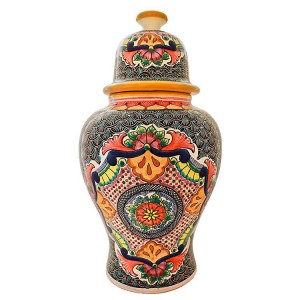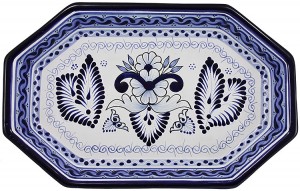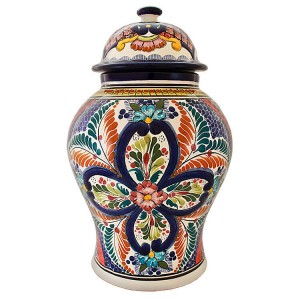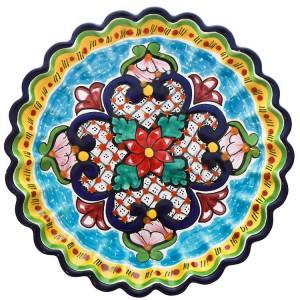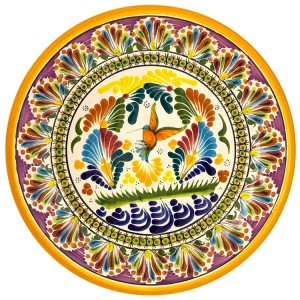 Techniques and designs of Islamic pottery were brought to Spain by the Moors by the end of the 12th century as Hispano-Moresque ware. From there they influenced late medieval pottery in the rest of Spain and Europe, under the name majolica.[5][15] Spanish craftsmen fromTalavera de la Reina (Castile, Spain) adopted and added to the art form. Further Italian influences were incorporated as the craft evolved in Spain, and guilds were formed to regulate the quality.
Techniques and designs of Islamic pottery were brought to Spain by the Moors by the end of the 12th century as Hispano-Moresque ware. From there they influenced late medieval pottery in the rest of Spain and Europe, under the name majolica.[5][15] Spanish craftsmen fromTalavera de la Reina (Castile, Spain) adopted and added to the art form. Further Italian influences were incorporated as the craft evolved in Spain, and guilds were formed to regulate the quality.
During roughly the same time period, pre-Hispanic cultures had their own tradition of pottery and ceramics, but they did not involve a potter’s wheel or glazing. There are several theories as to how majolica pottery was introduced to Mexico. The most common and accepted theory is that it was introduced by monks who either sent for artisans from Spain or knew how to produce the ceramics themselves. These monks wanted tiles and other objects to decorate their new monasteries, so to keep up with this demand, either Spanish artists or the monks taught indigenous artists to produce the glazed pottery. A significant number of secular potters came to Mexico from Seville and Talavera de la Reina, Spain during the very early colonial period. Later a notable potter by the name of Diego Gaytán, who was a native of Talavera, made an impact on pottery after he arrived in Puebla.
From the time that the city of Puebla was founded in 1531, a large number of churches and monasteries were being built. The demand for tiles to decorate these buildings plus the availability of high-quality clay in the area gave rise to the ceramic industry. It was soon produced by indigenous people as well as Spanish craftsmen, which resulted in a mixture of influences, especially in decorative design. The new tradition came to be known as Talavera Poblana to distinguish it from that of Talavera pottery from Spain.[2][6] By 1550, the city of Puebla was producing high-quality Talavera wares and, by 1580, it had become the center of Talavera production in Mexico.[5]
From 1580 to the mid-17th century, the number of potters and workshops kept growing, each having their own designs and techniques. The colonial government decided to regulate the industry with guilds and standards. In 1653, the first ordinances were passed. These regulated who could be called a craftsman, the categories of product quality, and norms of decoration.[14] The effect was to standardize the production of ceramics and increase the quality of what was produced. Some of the rules established by the ordinances included the use of blue cobalt on only the finest, quality pieces, the marking of pieces by craftsmen to avoid counterfeits, the creation of categories of quality (fine, semi-fine and daily use), and yearly inspections and examination of master potters.[1]
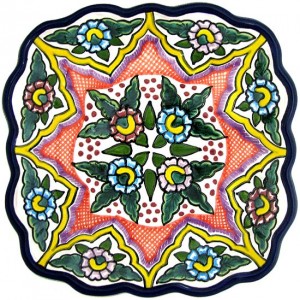 The period between 1650 and 1750 was known as the Golden Age of Talavera. Puebla became the most important earthenware center of New Spain. Pieces were shipped all over the territory, and were sent to Guatemala, Cuba, Santo Domingo, Venezuela and Colombia. During this time, the preferred use of blue on Talavera pottery was reinforced by the influence of China’s Ming dynasty through imported Chinese ceramics that came to Mexico via the Manila galleons. Italian influences in the 18th century introduced the use of other colors.
The period between 1650 and 1750 was known as the Golden Age of Talavera. Puebla became the most important earthenware center of New Spain. Pieces were shipped all over the territory, and were sent to Guatemala, Cuba, Santo Domingo, Venezuela and Colombia. During this time, the preferred use of blue on Talavera pottery was reinforced by the influence of China’s Ming dynasty through imported Chinese ceramics that came to Mexico via the Manila galleons. Italian influences in the 18th century introduced the use of other colors.
During the Mexican War of Independence, the potters’ guild and the ordinances of the 17th century were abolished. This allowed anyone to make the ceramic in any way, leading to a decline in quality.The war disrupted trade among the Spanish colonies and cheaper English porcelain was being imported. The Talavera market crashed. Out of the forty-six workshops that were producing in the 18th century, only seven remained after the war.
In 1897, a Catalan by the name of Enrique Luis Ventosa arrived to Puebla. Ventosa was fascinated by the history of the craft which was unique from other art forms in Mexico. He studied the original processes and combined it with his knowledge of contemporary, Spanish work. He published articles and poems about the tradition and worked to decorate ceramic pieces. In 1922, he befriended Ysauro Uriarte Martinez, a young potter, who had inherited his grandfather’s workshop. The two men collaborated to create new decorative designs, adding pre-Columbian and Art nouveau influences to the Islamic, Chinese, Spanish and Italian influences that were already present. They also worked to restore the former levels of quality. Their timing was good as the Mexican Revolution had ended and the country was in a period of reconstruction.
However, by the 1980s, there had been a further decline in the number of workshops until only four remained. Talavera had been under pressure in the latter part of the 20th century because of competition from pottery made in other Mexican states, cheap imports and the lack of more modern and imaginative designs.[4] In the early 1990s, the Talavera de la Reina workshop began revitalizing the craft by inviting artists to work with their artisans to create new pieces and new decorative designs. Among the artists wereJuan Soriano, Vicente Rojo Almazán, Javier Marín, Gustavo Pérez, Magali Lara and Francisco Toledo. They did not change the ceramic processes, but added human forms, animals, other items and traditional images of flowers to the designs.
Since then there has been some resurgence in the craft. In the 2000s, seventeen workshops were producing Talavera in the old tradition. Eight were in the process of becoming certified. These workshops employed about 250 workers and exported their wares to the United States, Canada, South America and Europe.
Although the Spaniards introduced this type of pottery, ironically the term Talavera is used much more in Mexico than in Talavera de la Reina, Spain, its namesake. In 1997, the Denominación de Origin de la Talavera was established to regulate what pieces could be officially called Talavera. Requisites included the city of production, the clay that was used, and the manufacturing methods. These pieces now carry holograms. One of the reasons the federal law was passed was that the remaining Talavera workshops had maintained the high quality and crafting process from the early colonial period, and the goal was to protect the tradition.
However, the tradition still struggles. Angelica Moreno, owner of Talavera de la Reina, is concerned that the tradition of the craft is waning, despite her workshop’s efforts. One problem the craft faces is the lack of young people who are interested in learning it. An artisan earns about 700 to 800 pesos a week, which is not enough to meet expenses.
Since the 16th century, Mexican craftsmen have been producing Talavera pottery. This art form has evolved from ancient cultures and influenced the production of pottery in Mexico resulting in the exquisite Talavera pottery that is available today. True, certified Talavera pottery is produced in the city of Puebla, in the state of Puebla, Mexico however, high-quality, modern Talavera pottery is also available from factories in other Mexican districts such as Dolores Hidalgo and Guanajuato.

